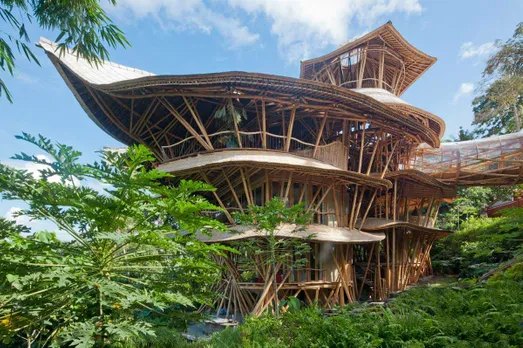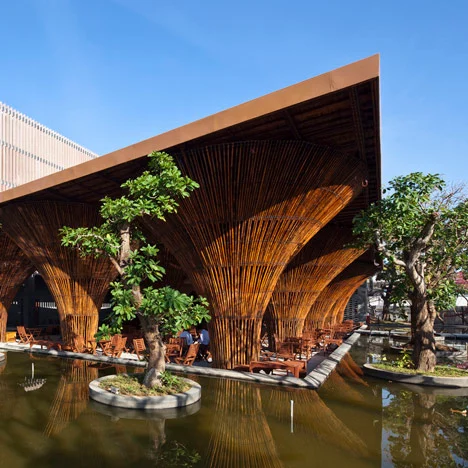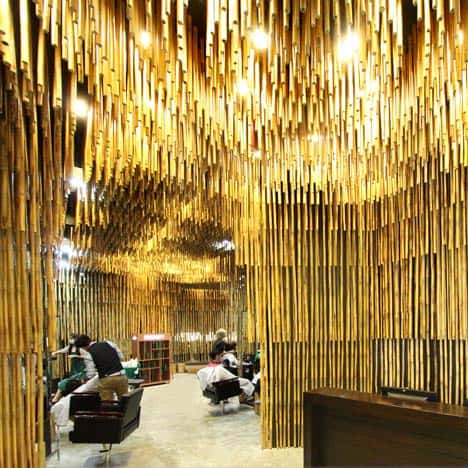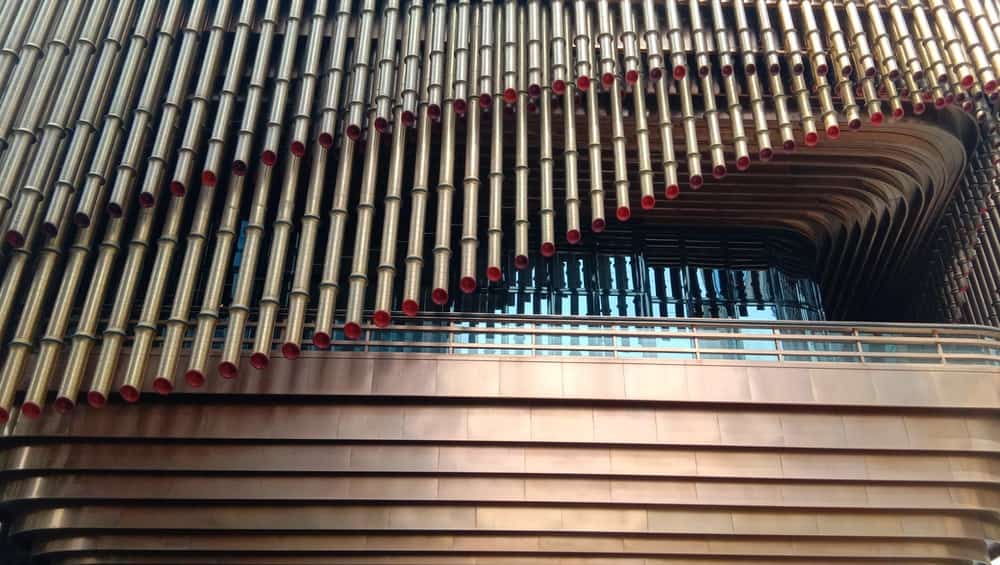Bamboo is a great building material, and it can be extremely easy to build with once you know a few basic techniques. Imagine, for instance, a home constructed entirely of bamboo—natural yet contemporary, simple yet appealing, rustic yet safe.
How-to books, rigorous courses, and full-service architecture firms are just a few of the many bamboo resource materials available. Finding one that highlights the bamboo building, however, can be challenging. We're here to help.
Can Bamboo Be Used for Construction?
Bamboo houses are currently being constructed all over the world. They're not just shabby bundles of thatch roofs and wooden sticks, either. Bamboo constructions aren't what they used to be, whether for low-cost housing in developing countries or exquisite sustainability in affluent communities.
Bamboo is usually associated with Southeast Asia, Central America, and South America, where the environment is best suited to its cultivation.
What Type Of Bamboo Is Best For Building
It is vital to pick bamboo varieties that are appropriate for construction. Some bamboo kinds, for example, are suitable for structural poles, whereas others are better suited for wall construction. If you don't sure what types you have, you can always run an engineering test to see what loads they can handle.
Here are a few kinds of bamboo you can use for a bamboo structure:
- Bambusa Blumeana- This type of bamboo is thorny, highly sturdy, and good for building. However, it struggles to grow straight and is more susceptible to powder post battles, unlike other bamboo species.
- Bambusa oldhamii- This type has a diameter of around 4-5 inches, grows straight and long, and has a very thick wall. It is best used for rafters and other non-structural architectural parts.
- Bambusa Vulgaris- This bamboo grows in clumps and is found practically everywhere in Hawaii. It is mostly suitable for load-bearing holes but best used in situations where the big non-load bearing poles are required.
- Dendrocalamus Asper- You can use this type of bamboo for structural elements of a building. It can grow to about 8 inches in diameter.
- Dendrocalamus Asper F. Niger- This is similar to the above type, but this is black.
- Gigantochloa Apus- These species are best used as rafters or scaffolding.
- Gigantochloa Atroviolacea- This is similar to the one above; however, this is black.
- Phyllostachys Aurea- This is one of the most prevalent bamboos in the united states. It is a spreading bamboo that can be used for interior design or as a non-load-bearing timber.
- Thyrsostachys Siamensis- It is best used for non-load bearing practices by bamboo enthusiasts.
Guide to Building with Bamboo
1. Tools
With bamboo construction, the tools needed are not very complicated. Having proper tools can help you speed up the process of building with bamboo. Here is a list of a few tools that are required for the construction of a bamboo house;
- Bamboo splitter (4X)
- Bamboo splitter (6X)
- 12-inch ⅜” -½” Drill Bit
- Mallet or hammer
- Circular saw, or hand saw
- Bamboo carving knife
- Corded or Cordless power drill
- Sawzall
- Orbital Sander
- Bamboo splitting
- Assorted Sized Hole Saws or Chisels
1. Preparing the Bamboo
Before bamboo can be used as a building material, it needs to be treated to get the proper form, bend, and length for structural or other purposes. Among the several tasks that must be completed are the following:
A). Breaking the Bamboo
A specific knife is used to cut the bamboo canes into quarters or halves, and a wedge is used to separate them. Four to eight segments are available, and they can be used as battens, strips, or canes. Up until the age of 18 months, canes can be peeled to make ropes and strings.
B). Shaping and Bending Bamboo
Despite their natural circular shape, bamboos will assume the appropriate shape if planted in a square box. It is possible to bend freshly cut bamboo by heating it to temperatures higher than 150° C. The bamboo retains its shape even after cooling and drying.
Is it Necessary to Treat Bamboo Before Building?
Many people think bamboo doesn't last long, and if you don't treat it, that's true. But bamboo can be made to last for decades!
Bamboo can be treated via heat treatment, pressure treatment, soaking, or vertical soak diffusion using a borax/boric acid mixture. When bamboo is treated with a borax/boric acid solution, the insects are poisoned by the inedible mixture that replaces the sweet starches they prefer.
2. Types of Joints
Traditional stick frame construction is different from bamboo architecture in a number of respects. Bamboo's circular shape necessitates handling it differently than dimensional lumber.
Although bamboo requires certain joints to attach two pieces, if you get the hang of them, they're almost as easy as any other connection you could make with ordinary wood.
The following joints are frequently found in bamboo construction:
a). Angle Joint
One of the most effective geometrical forms for preserving stiffness in bamboo constructions is the triangle. In order to ensure that constructions have shear strength—that is, that they don't seem wobbly—angle joints are utilized.
b). Fish Mount Joint
The Fish Mouth Joint is a frequent joint seen in bamboo structures. A fish mouth joint is formed when a vertical bamboo member strikes a horizontal bamboo member. It's a difficult joint to build at first, but once you get the hang of it, it's easy.
Once the mouth is finished, it is pinned together with a wooden dowel beneath the horizontal bamboo strip. Because it can be difficult to make this joint totally secure at times, a modified variant was created.
c). Modified Fish Mouth Joint
Like the fish mouth joint, this junction uses a piece of bamboo with a smaller diameter that slides into a hole drilled into the horizontal piece of bamboo and into the vertical piece. Bamboo pegs are used to secure the two portions after they are fitted together.
The smaller piece of bamboo makes more contact between the bamboo fish mouth and the bamboo pegs, ensuring a stronger bond.
3. The Foundation
The first and most important stage in any building development is to provide it a good foundation or a decent pair of boots. A traditional bamboo foundation consists of a base made of concrete pilings from which rebar extends.
On the concrete base, the lowest nodes of the bamboo are spread open and placed over the rebar; it is enough to place around two nodes up. To allow liquid concrete to be poured into and solidified, two holes are carved into the sides of the bamboo's lower nodes. This has shown to be the best foundation technique for a bamboo house.
Due to its rapid degradation when exposed to moisture, bamboo is rarely used as a foundation material. Nonetheless, this issue can be resolved with the right care and the application of the right chemicals.
The many varieties of bamboo foundations are as follows:
- Bamboo that is directly in contact with the ground.
- Bamboo is fastened to rock or prepared concrete foundations.
- Bamboo or concrete columns
- Bamboo piles
4. Structural Design
Bamboos are cultivated in such a way that as they develop, they take on the required forms and structures. Here are some common shapes and designs;
- Squared- A squared cross-section may be formed by compressing the developing stalk of bamboo within a square section.
- Arched- Bamboo arch designs can also be made by compressing the growth of the bamboo into the desired shape. This would be less expensive than making the same shape out of regular wood.
- Curved and Flattened Bamboo- Traditional bamboo shaping techniques such as pressure and temperature are used to create curved and flat shapes.
5. Walls Construction
Bamboo is frequently used for walls and partitions. Posts and beams, which provide walls their structural framework, are the fundamental components of bamboo building.
They positioned themselves such that they could withstand the forces of nature. An infill is used between frame components to increase the walls' strength and stability.
6. Roofing
One of the best roofing materials is bamboo, which adds strength to the structure. It is a tried-and-true defense against animal or natural forces, and because it is lightweight, it is easy to construct. The bamboo roofs are made of rafters, trusses, and purlins.
7. Scaffolding
Bamboo is one of the most often suggested scaffolding materials, particularly for tall buildings, because of its exceptional capacity to support heavy weights. For the purpose of building scaffolding, cane extensions are made by joining cane ends with several ropes.
The nodes are lodged in the lashing by vertical downward stresses caused by the arrangement of the ties. The re-alignment of the joints to the appropriate degree makes this method crucial.
What Do You Consider Before Building with Bamboo
1. Bamboo Supplier
Although bamboo is a robust material that is frequently used in place of steel, its fiber composition makes it extremely brittle and prone to splitting at its core. Investigate your options and make sure your bamboo provider is trustworthy.
2. Location
Road and topographical building conditions, water and electricity availability, local labor availability or lack thereof, and local materials availability or lack thereof.
3. Budget and Fees
What is the total cost of the project? What are the client's requirements for finishing and standards? This information is critical for the architect to begin brainstorming about the first design process and pricing.
4. Design
The bamboo house's design shape and difficulty level are more relevant and important than the overall area of the structure. Big buildings can proportionally be turned out to be cheaper than smaller structures.
5. Legalities Of Building With Bamboo
Bamboo is a great building material, as you can see. The only thing left to do is approve its use in building homes, especially in tropical regions. Bamboo can now be used to make furniture, shade structures, and gazebos that were previously prohibited.
6. Quality Control
For every project to be successful, on-site quality monitoring is essential. Only mature, completely dried bamboo should be used for construction. Drying causes bamboo poles to shrink, which causes them to split and shatter. Your bamboo poles should be no more than 18% wet before being utilized for construction.
Pros and Cons of Using Building with Bamboo
Pros
- Higher tensile strength as the fibers run axially
- The low weight makes construction and transportation easier
- Easy and cost-effective to use
- Great elastic features make it a good choice for earthquake-prone regions
- High fire resistant and can withstand very high temperatures of up to 4000 C.
- Safe with no dangers to health
Cons
- Preservation and treating are needed to improve durability
- Shrinks more than other types of timber.
- The structural reliability of bamboo buildings is questionable.
Best Bamboo Buildings
1. Sharma Springs in Bali

Image Source: ibuku.com
With six stories and breathtaking views of the surrounding bush, Sharma Springs is the tallest bamboo structure in Bali. Inspired by the design of a lotus flower, this enormous home is grand and magical.
2. Kontum Indochine Cafe
This waterside cafe by Vo Trong Nghia, who was featured in our series of interviews with architects about the new bamboo trend this week, is the second most popular.

Image Source: dezeen.com
The top-heavy columns in this restaurant, which were created for the Kontum Indochine Hotel in the designer's native Vietnam, are reminiscent of the traditional fishing baskets used in the area. The firm's designs for the Milan Expo Pavilion in Vietnam also echo those of the country.
3. Bangkok Hair Salon

Image Source: dezeen.com
Natural caves served as inspiration for Thai designer Nattapon Klinsuwan of NKDW Studio's distinctive hair salon design. To distinguish the various interior zones, thousands of bamboo stakes were suspended from the ceiling in the shape of stalactites. These "stalactites" combine with "stalagmites," which are bamboo pegs that rise from the bottom, to form columns.
Frequently Asked Questions (FAQs) on Building with Bamboo
1. Why is bamboo not used in construction?
The main drawback of bamboo is that it cannot survive the weather in its natural state. Because bamboo attracts insects and fungi that cause disintegration, untreated bamboo constructions only endure a few years.
2. Is bamboo stronger than concrete?
Bamboo has a tensile strength greater than several steel alloys. Bamboo has a compressive strength greater than many concrete combinations.
3. Can I build with green bamboo?
It is not a good idea to build using green bamboo. Fresh bamboo is more vulnerable to mold and fungus due to pests and insects. In addition, the wood gets stiffer and loses about 10% to 15% of its diameter as it dries. After these procedures are finished, you can use it to build in a safe and secure manner.













